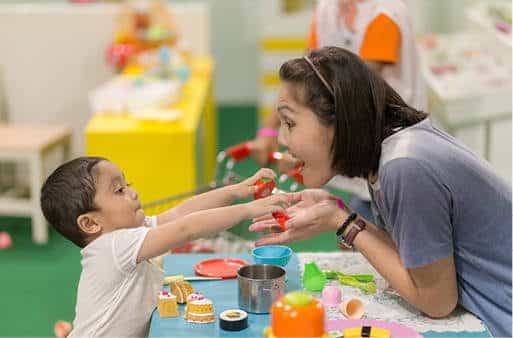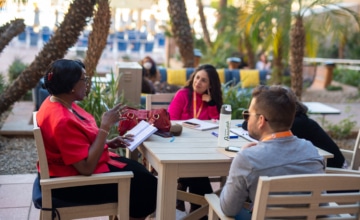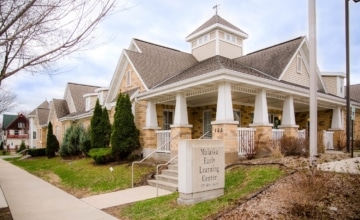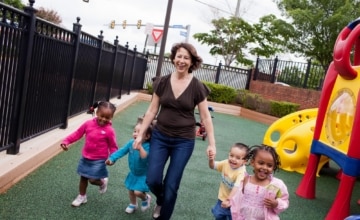Deborah Roderick Stark, Harwood, Maryland
Deborah Brown and Judith Jerald, Save the Children, Fairfield, Connecticut

Abstract
A secret sauce for family and community engagement emerged as a result of a technical assistance project that supported Early Head Start-Child Care Partnership grantees in California. Power-sharing, communication, creativity, and continuous recommitment to families were key ingredients of that sauce. When these were present, programs were able to engage in the systems changes that were needed to ensure partnerships flourish and move toward the ultimate goal of co-creation of policies and program activities with families and community.
What happens when you bring together traditional child care providers and Early Head Start programs to increase access to quality, comprehensive services in a community? Despite the messiness—and sometimes pique—caused by differences in financing, regulation, and culture, good things happen, especially when the partnerships embrace collaboration, take risks, and engage families and communities in new ways.
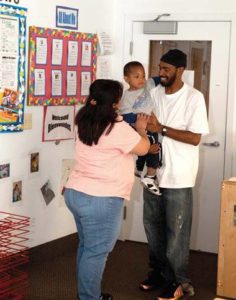
Child care providers moved from thinking of their client as the child to understanding the role they play in supporting both the child and family.
From 2015 through 2018, we had the opportunity to work with 20 Early Head Start-Child Care Partnership (EHS-CCP) grantees in California to support the early formation of their partnership and coach them to bolster their family and community engagement practices. We worked with these grantees via a mix of site visits, cluster meetings, statewide meetings, and webinars. Our team included coaches who were assigned to each grantee to provide consistent guidance and support as they developed a baseline assessment of their family and community engagement practices and goals for making those practices even more impactful. We also had a researcher on our team who taught the teams about action research and continuously reminded all of us to reflect on our experiences and use those reflections as a jumping off point for testing new directions and approaches. And we had connectors who kept the project moving and made sure we were making use of relevant tools, resources, and experts.
Looking back, we are impressed by just how much systems change is needed to ensure these partnerships flourish and that they adopt practices that inch toward the ultimate goal of co-creation of policy, program, and support with families and community. We saw important shifts in several areas, including the following:
- Parents who previously thought they could drop and dash to their other commitments were now serving on curriculum committees and engaged in planning and implementation of the program activities.
- Child care providers moved from thinking of their client as the child to understanding the role they play in supporting both the child and family, and that it begins with building relationships with parents, asking parents what they need and want, and communicating respectfully.
- Administrators learned how to take a step back and share power with staff and families which resulted in broader ownership of the program from all those involved.
- EHS programs were challenged to think outside the Head Start box to recognize and appreciate the different cultures of child care, and also to double down and embrace their own continuous improvement as it relates to family and community engagement.
Representatives from two of our EHS-CCP teams presented at the 2018 National Head Start Association Parent Engagement Conference. These programs—Child Start, Inc. (the EHS grantee) and Napa Valley Unified School District (the partner); and Plaza Community Services (the EHS grantee) and the Salvation Army Child Care (the partner)—spoke of their “secret sauce” for achieving new heights of engagement. They identified five key ingredients:
- The first ingredient of their sauce is “Share the Power: Co-Create a Vision for Parent Engagement With Families.” Juan Cisneros shared a strategy that Child Start used in partnership with center and family child care partners to create vision boards of what they wanted family engagement to look like in their business, and then the partners did the same exercise with their families. This exercise helped the grantee, partners, and families all understand how each envisions words such as family success and school readiness, and it helped them to see that there are opportunities to engage parents in every aspect of the program. “Co-creating a vision for parent engagement with parents and sharing the power is a good way to set the tone from the onset because essentially, we’re inviting and welcoming parents in and letting them know that we value their voice and opinion. Together we can maximize the services provided and outcomes achieved when we work as a team,” said Cisneros.
- The second ingredient is “Increase Awareness and Understanding of the Head Start Parent, Family and Community Engagement Framework.” Originally developed in 2011, the Framework is the base of the secret sauce. It highlights the core program elements that contribute to family and child outcomes. All of the elements are rooted in positive and goal-oriented relationships as well as equity, inclusiveness, and cultural and linguistic responsiveness. Program leadership, staff, and families all need to understand the Framework and determine how they will operationalize it in their program. For example, what competencies will they look for when hiring staff, or what professional development will be provided to ensure staff understand how to engage families in positive and goal-oriented relationships? What specifically will the program do to support family well-being or parent–child relationships? Understanding the Framework and then co-creating a plan with administrators, staff, and families for how the Framework will be used in the program will ensure common understanding and increased awareness of actions that can be intentionally taken to boost family and community engagement practices for the benefit of strengthening family and child outcomes.
- “Sugar Over Vinegar,” is the third ingredient. Audrey Chubbs reminded us that, “We all know that the best recipes require a little something sweet! The all-important ‘sugar’ of this special sauce is communication. Being intentional about how we communicate with families helps to build positive relationships.” She emphasized the importance of getting to know families and learning what method of contact works best for them. From social media to face-to-face check-ins and family activities, she focused on building trust through effective communication.
- The fourth ingredient of the secret sauce is “Be Creative. Be Extraordinary.” No partner demonstrated this with more precision than Mary Ruelas. For example, when Ruelas worked with a parent “curriculum ambassador” during curriculum planning, they created authentic parent engagement by calling on the special talents, skills, and passions of the parents at that center, who mostly worked in the garment and piñata district of Los Angeles. A group of parents capitalized on the traditional dinosaur unit and built a 4-dimensional dinosaur environment that mesmerized the children, bringing what they were reading in books to life. Parents were proud that they created something that enhanced their children’s leaning; and children delighted in knowing their parents played a role in creating the spectacular display. Science, technology, engineering, and math learning were enhanced and literacy was reinforced as children joined their parents in reading stories about dinosaurs while surrounded by a life-like dinosaur environment.Ruelas applied “Be Creative. Be Extraordinary” to her connections with community partners as well. She recognized that her parents were busy and there were many challenges for them to engage with programs in the community—including transportation, work schedules, and immigration worries. So she found ways for her program to be a bridge between families and community resources. She brought those who offer CPR training and car seat safety checks to the program. When parents and staff raised concern about the safety of morning drop-off, a neighborhood police officer stepped up and adopted the program, working with the administration and parents to set cones in the street and establish a safe system. And that same officer taught the children about street safety in developmentally appropriate ways. Ruelas muses how one day an amazed parent approached her and said, “What are you teaching my child? We were going to cross the street and he said ‘Mama, put your phone away and hold my hand because we need to be safe when we cross the street.’”
- The fifth secret ingredient in the family and community engagement sauce is “Continuous Recommitment to Families.” Ingrid Estrada-Darley spoke of the importance of regularly reviewing family and community needs and assets in order to notice shifts that may affect one’s ability to engage families, other agencies, and the community. A strategy that worked last year or even last week may need to be re-tooled to work today. Open and ongoing communication with families and staff will help to keep a program dynamic. She emphasized that continuously recommitting to families means a continuous commitment to equity. “Families who are under the stress of homelessness, immigration proceedings, or those who have experienced trauma will need more support and effort to help them reach full engagement with the program.”
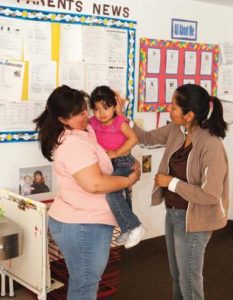
Open and ongoing communication with families and staff will help to keep a program dynamic.
It was truly a delight to be able to work with the EHS-CCP teams to help them build relationship and achieve new levels of engagement. It took a “secret sauce” of power-sharing, understanding, communication, creativity, and recommitment to make the recipe work. With this work, we saw programs deepen their commitment to partnership, co-create with families, and lift up the quality of early childhood care in their communities. From our experience, it is evident that EHS-CCP is achieving the goal set forth by the federal government to increase access to quality early childhood programs. And in doing so, these programs are providing hope, opportunity, and resources to families so that they can be their child’s first and life-long teachers.
Acknowledgment
The project was funded by the Heising-Simons Foundation of Los Altos, California.
Authors
Deborah Roderick Stark, MSW, is a nationally recognized expert in child and family programs, research, and policy. The founder of Deborah Roderick Stark and Associates, she has more than 20 years’ experience working with foundations, public agencies, and the nonprofit sector. She guided development of Early Head Start in the Clinton Administration. She has authored or provided research for critical books, articles, and papers on topics including family engagement, early childhood education, infant and early childhood mental health, and maternal and child health. Stark can be reached at: drs889@gmail.com.
Deborah Brown, PhD, is a consultant for US Programs at Save the Children. Dr. Brown integrates practice with critical inquiry. As a program evaluation researcher, she works collaboratively with organizations and government agencies to use structured inquiry as a program and project improvement tool. She has taught graduate-level courses in organizational theory and behavior, leadership, and systems theory. Dr. Brown is the principal investigator for Save the Children’s Early Steps to School Success program, an early childhood literacy program implemented in 94 sites in 12 states in the US.
Judith Jerald, MSW, is senior advisor for Early Childhood Programs and Policy at Save the Children, US Programs. She previously was responsible for designing, developing, and managing birth to age 5 programs in rural, poor communities throughout the US, including a birth to 5 home visiting program and Early Head Start and Head Start. She is the former national director of Early Head Start, and was the Head Start division director for Program Support, Birth to Five, at the Office of Head Start in Washington DC.
Suggested Citation
Stark, D. R., Brown, D., & Jerald, J. (2019). PERSPECTIVE—A secret sauce makes the family and community engagement recipe work. ZERO TO THREE Journal, 39(5), 54–57.

